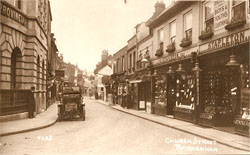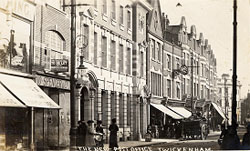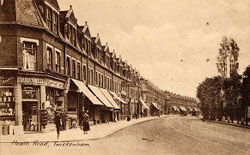Shopping in Twickenham
Development of roads leads to a busy 19th century shopping centre

Most of the main shopping roads of Twickenham are ancient routes through the town. Church Street, King Street, London Road and Heath Road are clearly shown on the earliest maps of the town. Church Street led to St Mary's Church and beyond to what became Richmond Road, leading to Richmond ferry until the bridge was built. London Road led to Isleworth and Brentford and so to London. Heath Road led to Hounslow Heath and the roads to Hampton and Staines. King Street connected all the main roads to and from Twickenham. The exception is York Street, only built in 1899, to relieve the ancient and very narrow Church Street.
The roads gradually improved over the years. An act of 1767 set up the Isleworth, Twickenham and Teddington Turnpike Trust to improve the route that included London Road and King Street. The opening of Richmond Bridge, in 1777, led to improvements and increased traffic on Richmond Road. Eventually the bottleneck of Church Street on this route led to the building of York Street. King Street was dramatically widened in the 1920s and in Heath Road shops gradually replaced the line of former large houses.

The presence of the Church gave Church Street its name and it was so-called in the 17th century, if not earlier. The Moses Glover map of 1635 shows both sides of the Street lined with buildings. By the end of the century “The Fox” (then known as “Le Bell”) stood on the south side of the street, as today. By the 18th century there were a number of better off families with property or trade in Church Street. By 1898-9 there were some 35 traders including 5 butchers and 3 bakers. The widening of King Street in the late 1920s drew trade away so that eventually Church Street became something of a backwater and remained so until the 1970s. In the 1970s and 1980s there was new development gradually leading to a more vibrant and less run-down look for Church Street.
While Church Street still retains its scale with many old buildings, King Street changed almost out of recognition in the 20th century. It, too, was a very ancient street and as early as 1770 had been referred to as the “Great Street”. Coaches to and from London ran from the inns here: The George, built in 1737 and The King's Head, in 1747. There were 7 coaches daily in 1811 and 26 a day by 1837. The number of retail businesses in 1898-9 shows that King Street was challenging Church Street as the main shopping street of the town. Before the changes of the 1920s King Street was described as being “extremely narrow - half the width it is today”. On the south side of King Street “from Wharf Lane to half way along the street was a blank wall. Behind the wall was Richmond House”. Next to Richmond House was the Town Hall. The King's Head and all of the buildings fronting the south side of King Street were swept away in 1928 for road widening. Following this, with the construction of purpose-built shops on the whole length of the south side, and partial redevelopment of the north, King Street became and remains the predominant area for shopping.

Essentially a continuation of King Street to the north, London Road began at Page's corner, dominating the east end of King Street, and ran to Ivy Bridge, although the retail area has not extended significantly beyond the railway bridge. In 1898-9, when part of London Road had already been knocked down to allow York Street to be driven through the street had a total of 43 retail businesses including 4 public houses. The Post office moved to a new building from King Street in 1908 and only closed in recent years.
York Street, officially opened in 1899, was built to relieve the very narrow Church Street, joining Richmond Road just before Oak Lane. A number of properties had to be compulsorily purchased by the Council who put on sale plots of land adjoining the new street in 1900. The development of York Street was relatively slow; by 1907 there were still only 3 businesses on the north side. By 1920 the total, in the street, had increased to 37 traders and York Street was fully established.
Heath Road was an ancient route to Hampton and Staines through the southern part of Hounslow Heath. It remained less developed than the other shopping streets until the end of the 19th century. In the 1870s it was a very quiet lane with a few good houses on both sides. Until the end of the century there were shops only along the north side from the junction with King Street to just past what is now Copthall Gardens, and a cluster of businesses by The Dip. By 1907 the large houses, with the exception of Clifden House, had been swept away and the familiar long parades of shops with accommodation above were replacing them. On the north side it took until the 1930s for the last remnants of the 18th century to be demolished and for purpose-built shops to line the road.

At the end of the 19th century the eastern end of Richmond Road in East Twickenham was largely rural. Then, as houses and roads were constructed in 1899, three parades of shops were built. These were Richmond, Richmond Bridge Mansions and Cambridge Parades, with flats above. The new shopping centre of East Twickenham had been established.



